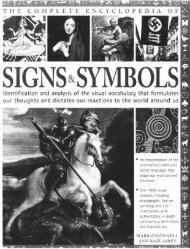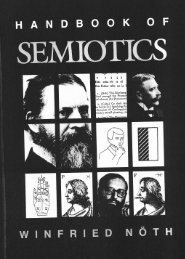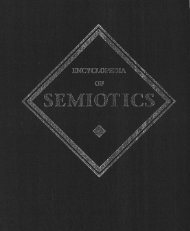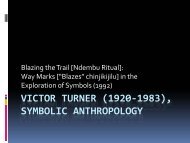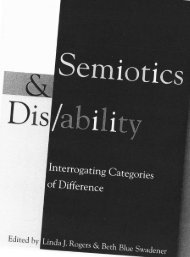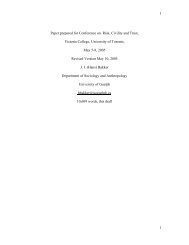Musical Semiotics in Growth - SemioticSigns.com
Musical Semiotics in Growth - SemioticSigns.com
Musical Semiotics in Growth - SemioticSigns.com
You also want an ePaper? Increase the reach of your titles
YUMPU automatically turns print PDFs into web optimized ePapers that Google loves.
90 Mtu'iei ,lrrl'tfttri,skr<br />
Vttlrtc,s and their cognition <strong>in</strong> the semiotic theory ctf C.S.pcirce<br />
gl<br />
reflection). s<strong>in</strong>ce at the moment when we realiz.e the fact that<br />
"somelh<strong>in</strong>g" is "first", that "someth<strong>in</strong>g" ceases be<strong>in</strong>g "first" and<br />
l'recornes "second". i.e.. "soureth<strong>in</strong>g" that has ctlttte <strong>in</strong>ttl existence <strong>in</strong> the<br />
p11rst rudimentary lirrnt itt ()Llr cttt.tsciousness. While Secondness<br />
<strong>in</strong>trochrccs lhe elcntent o1' "cliscretencss" to our cclnsciousncss. 'l'hirdness<br />
ret-ers to relations charactcristic of evetrts, phenttmena, tlh.jccts.<br />
Therefirre, Thirclncss is a category of "law", "relativity", "rule".<br />
Ref'err<strong>in</strong>g here to tltc earlicr mentioned exatnplc (adduced by Peirce) of<br />
a musical work, we can state that <strong>in</strong> a direct, pre-reflectional perception<br />
it appears as a category of [;irstness. Then, after a def<strong>in</strong>ite existence of<br />
the particular souttcl <strong>in</strong> "t<strong>in</strong>re atrd space". it is seen as Secondness; while<br />
<strong>in</strong> the frorn of an identifiablc structrlre of morphtllogical elements it is a<br />
category of the Thirdness.<br />
This rcl'erence to the thcorv of "category", although carried out <strong>in</strong> a<br />
rathcr superficial and abbrcviated filrm, facilitates and <strong>in</strong> some degree<br />
"softens" our pass<strong>in</strong>g <strong>in</strong>to thc sphere of connectiotrs betweetr Peirce's<br />
conception of aesthctics and his theory of signs. Def<strong>in</strong><strong>in</strong>g the <strong>in</strong>terpretant<br />
as thc: "proper cfl'cct of thc ntean<strong>in</strong>g" ttf tltc sign. Pcirce madc two<br />
significarrt triaclic clivisiotts of thc category of ntean<strong>in</strong>g. devclop<strong>in</strong>g<br />
particularly the analysis of onc of them, namely. thc logical <strong>in</strong>terpretant.<br />
Accorcl<strong>in</strong>g to the classification bascd on the ontological categories. the<br />
<strong>in</strong>terpretant is dcf<strong>in</strong>ed as the category of Thirdness. At the same time,<br />
we obta<strong>in</strong> three types of <strong>in</strong>terpretants: the direct, the dynamic, and the<br />
l-<strong>in</strong>al <strong>in</strong>terpr-etant. Ry means of the sccond of the proposed divisions -<br />
crnotioual, cnergetic. and logical <strong>in</strong>terpretattlsr - alrd its usability for<br />
lurther considerations, I shall fircus my attention on the direct and<br />
dyuaurie <strong>in</strong>tclprcturlts.<br />
The first of the above-tnentiotred types of <strong>in</strong>terpretant refers to the<br />
sign "itsclf" (rnediurn of transfer <strong>in</strong> the tcrm<strong>in</strong>ology of Bense) and is<br />
clel<strong>in</strong>ed as the ". . effect evoked by the sigtt without carry<strong>in</strong>g out any<br />
reflection on il" (Bense 1980: 43). The sccond type, the dynamrc<br />
<strong>in</strong>terpretant, is "thc real cl'f'ecthat the given sigtl cxerts" (Bttczynska<br />
197-5: 133). It consists irr thc "direct cf'f'ect factually excrted by thc sigtt<br />
orl its <strong>in</strong>terprctcr" (ihid.). Utilizirrg aga<strong>in</strong> the classification of<br />
<strong>in</strong>terprclants on the basis of tlntological "categorics", we filrd rn<br />
rct'erence t



